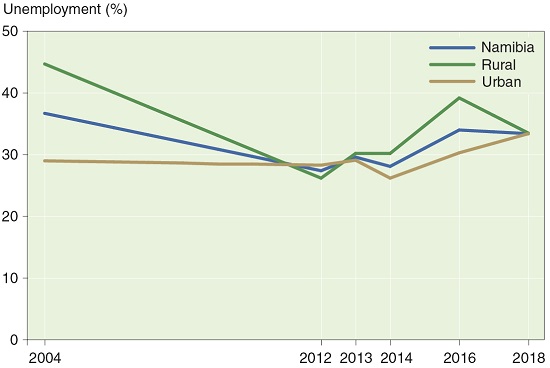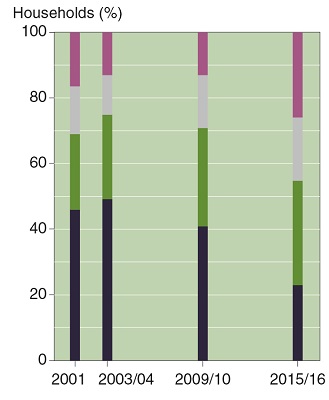Employment
Regular labour force surveys are used to measure employment and unemployment rates. These are proportions of people in Namibia's potential labour force who work or do not work, respectively. The labour force consists of everyone who is 15 years and older and who is available to work regardless of age, but it excludes people who are unable to work, such as full-time students or homemakers or those who are ill, disabled or retired.
Three categories are recognised amongst those who are employed. Formal employment offers at least membership of a pension scheme, medical aid and/or social security. Workers who lack these benefits are placed in the category of informal employment. Most of them are farmworkers, domestic servants, labourers, cleaners or general assistants. Vulnerable employment describes occupations that are insecure, with few or no formal arrangements. Most often, it refers to communal farmers, unpaid family members or people who are self-employed.

Photo: J Mendelsohn
Especially over weekends, unemployed men gather to seek temporary jobs on certain of Windhoek's street corners. Unemployment rates have risen in recent decades while poverty rates have dropped. This apparent paradox arose as Namibians have moved away from the income poverty of subsistence livelihoods in rural areas to cash incomes in urban areas. This is not an economic paradox but a statistical one, and a consequence of how employment is measured. Take this illustrative example: a young man or woman living in a communal area is informally employed as a farmer, but having moved to town, the same person may earn a moderate income in the informal sector. He, or she, is now often better off but would normally be reported as unemployed since that is what the person answered even though she or he was doing a casual job.
10.06 Unemployment rates, 2004–20185

Between 2004 and 2014, urban unemployment was relatively constant, while unemployment in rural areas decreased initially and then rose again. Some of these changes, however, reflect changing definitions of employment over the years. This is especially true in the case of rural smallholders who farm largely for domestic consumption; at different times, they have been regarded as employed or as unemployed (in particular, if they reported that they were also seeking employment). In 2018, unemployment rates stood at 33.4 per cent in both rural and urban areas.
10.07 Youth unemployment, 2013–20186

Unemployment rates among the youth (aged 15–34 years, and neither full-time students nor home-makers) increased over the period 2013–2018, with close to half of these young people unemployed by 2018.
Younger people in this age group are more likely to be unemployed than older people. In 2018, for example, 69.9 per cent of people aged 15–19 years were unemployed compared to 57.0 per cent of people aged 20–24 years, 42.3 per cent of people aged 25–29 years and 32.5 per cent of those aged 30–34 years.
10.08 Regional employment and unemployment rates, 20187

Namibia had a labour force of 1,090,153 people in 2018.8 Of that potential labour force, 33.4 per cent were unemployed, 28.2 per cent were formally employed, 17.4 per cent were employed informally and 21.0 per cent were employed in vulnerable occupations, as defined in the introduction to this section on employment.
Rates of formal employment were only high in urban areas and in those regions dominated by urban populations, such as Erongo, Khomas and ||Kharas. The highest unemployment and vulnerable employment rates were in rural areas, particularly in northern Namibia where many people work their fields to grow food for domestic consumption.
10.09 Main sources of household income, 2001–20169
Namibia

Urban

Rural


The percentage of households in rural areas for which farming was a main source of income in 2001 halved by 2015/16 to about 22 per cent. Thus, only about one in five rural households derived their main income from farming in 2016, while salaries, pensions and other types of income (mainly remittances, grants and trade in goods and services) became more important in contributing to household income. Although farming has decreased in importance, the numbers of livestock in communal areas have increased dramatically, while numbers of livestock on freehold farms have decreased (figure 8.03).

